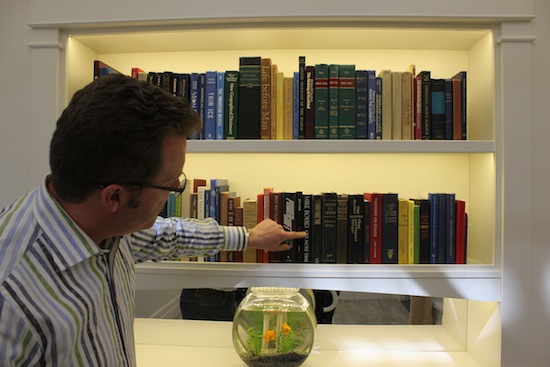Special delivery! See our visiting baby camels (Dec. 6–19) and yaks (Dec. 20–Jan. 5) this holiday. Learn more
The Academy's Earthquake exhibit explores the Earth's tectonic plate movement on a vast geological timescale, the effects of earthquakes on a more immediate human timescale, and quake preparedness tips for living in seismically active regions such as the Bay Area.

Scott Moran in front of Shake House bookshelf
In the Shake House, the titles on the bottom bookshelf are:
- Earth
- An Ever-Changing Place
- Early Warning
- The Imperial Mantle
- Earth in Motion
- The Story of our Earth
- The Story of Mechanics
- The Story of Force and Motion
- The Earth Before Man
- Our Beginnings in the Old World
- The Majestic Rocky Mountains
- America
- Your Land and Mine
- San Francisco
- San Francisco in Color
- Oh, California
- Pacific Rift
- The Last Place on Earth
- Our Town
- Plain Talk from the Hill
- Tales of Land and Sea
- A World Unsuspected
- Catastrophe!
- Life on the Line
- Power Shift
- Fire
- One More Time
- Unforgettable Fire
- Ashes to Ashes
- Design of Masonry Structures
- Clear and Present Danger
- Sign of Chaos
- Thriving on Chaos
- Lord of Chaos
- Alarms and Diversions
- Losing our Cool
- Heat
- Studies on Hysteria
- This Moment on Earth
- Making Peace with the Planet
- The Winds of Change
- Disaster Preparedness
Fun Facts
- Inside the Shake House, the walls are painted white. Everything that rattles and bounces during a quake is brightly colored.
- "Water" in the sealed fish bowl is actually mineral oil. It was chosen because actual water would turn green with algae growth and need to be regularly changed.
- This room has no breakable items. The plates, glasses, mirror and fishbowl are all made of plastic.
- The chandelier uses LED light strips to simulate incandescent lighting of 1989 and the flickering gas lights of 1906.
- Be sure to look at the titles on the lower shelf of the book case. Reading from left to right, you'll see how these titles literally spell out the larger idea behind the entire Earthquake exhibit.
- The room's framed painting pays tribute to the schooner Academy, an 89-foot sailing vessel that took Academy scientists to the Galapagos Islands in 1905. The great 1906 earthquake struck San Francisco during the expedition, destroying the Academy's original Market Street building and a majority of the collection. The 75,000 specimens collected in the Galapagos formed the basis of the new, rebuilt Academy in Golden Gate Park.
—Barbara Tannenbaum